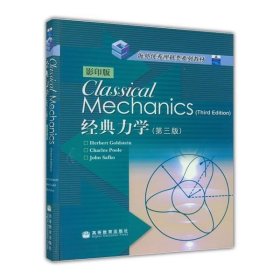
【正版现货闪电发货】Classical Mechanics 3rd edition 影印版 经典力学 Goldstein 高等教育出版社
9787040160918
¥ 62.1 全新
库存2件
江苏南京
认证卖家担保交易快速发货售后保障
作者作者
出版社高等教育出版社
ISBN9787040160918
出版时间2023-06
装帧平装
开本16
货号44244609173
上书时间2024-06-21
- 最新上架
商品详情
- 品相描述:全新
- 商品描述
-
Classical Mechanics(3rd edition)(影印版)经典力学(第三版)
作者: Goldstein
出版社: 高等教育出版社
ISBN: 9787040160918
开本: 16开
出版日期:2005年2月
装帧: 平装
定价: 72.00
版次: 1
字数: 850千字
是否套装: 否
页码: 660
套装数量: 0
美国哥伦比亚州大学Herbert Goldstein编著的《经典力学》(Classical Mechanics)是一本有着很高知名度的经典力学教材,长期以来被世界上多所大学选用。本影印版是2002年出版的第3版。与前两版相比,第3版在保留基本经典力学内容的基础上,做了不少调整。例如,增加了混沌一章;引入了一些对新研究问题的方法的讨论,例如张量、群论的等;对于第二版中的一些内容做了适当的压缩和调整 全书共13章,可作为为物理类专业经典力学课程的教材,尤其适合开展双语教学的学校,对于有志出国深造的人员也是一本必不可少的参考书。
1 Survey of the Elementary Principles
1.1 Mechanics of a Particle
1.2 Mechanics of a System of Particles
1.3 Constraints
1.4 D’Alembert’s Principle and Lagrange's Equations
1.5 Velocity-Dependent Potentials and the Dissipation Function
1.6 Simple Applications of the Lagrangian Formulation
2 Variational Principles and Lagrange’s Equations
2.1 Hamilton’s Principle
2.2 Some Techniques of the Calculus of Variations
2.3 Derivation of Lagrange’s Equations from Hamilton's Principle
2.4 Extension of Hamilton’s Principle to Nonholonomic Systems
2.5 Advantages of a Variational Principle Formulation
2.6 Conservation Theorems and Symmetry Properties
2.7 Energy Function and the Conservation of Energy
3 The Central Force Problem
3.1 Reduction to the Equivalent One-Body Problem
3.2 The Equations of Motion and First Integrals
3.3 The Equivalent One-Dimensional Problem, and Classification of Orbits
3.4 The Virial Theorem
3.5 The Differential Equation for the Orbit, and Integrable Power-Law Potentials
3.6 Conditions for Closed Orbits (Bertrand’s Theorem)
3.7 The Kepler Problem: Inverse-Square Law of Force
3.8 The Motion in Time in the Kepler Problem
3.9 The Laplace-Runge-Lenz Vector
3.10 Scattering in a Central Force Field
3.11 Transformation of the Scattering Problem to Laboratory Coordinates
3.12 The Three-Body Problem
4 The Kinematics of Rigid Body Motion
4.1 The Independent Coordinates of a Rigid Body
4.2 Orthogonal Transformations
4.3 Formal Properties of the Transformation Matrix
4.4 The Eiller Angles
4.5 The Cayley-Klein Parameters and Related Quantities
4.6 Euler’s Theorem on the Motion of a Rigid Body
4.7 Finite Rotations
4.8 Infinitesimal Rotations
4.9 Rate of Change of a Vector
4.10 The Coriolis Effect
5 The Rigid Body Equations of Motion
5.1 Angular Momentum and Kinetic Energy of Motion about a Point
5.2 Tensors
5.3 The Inertia Tensor and the Moment of Inertia
5.4 The Eigenvalues of the Inertia Tensor and the Principal Axis Transformation
5.5 Solving Rigid Body Problems and the Euler Equations of Motion
5.6 Torque-free Motion of a Rigid Body
5.7 The Heavy Symmetrical Top with One Point Fixed
5.8 Precession of the Equinoxes and of Satellite Orbits
5.9 Precession of Systems of Charges in a Magnetic Field
6 Oscillations
6.1 Formulation of the Problem
6.2 The Eigenvalue Equation and the Principal Axis Transformation
6.3 Frequencies of Free Vibration, and Normal Coordinates
6.4 Free Vibrations of a Linear Triatomic Molecule
6.5 Forced Vibrations and the Effect of Dissipative Forces
6.6 Beyond Small Oscillations: The Damped Driven Pendulum and the Josephson Junction
7 The Classical Mechanics of the Special Theory of Relativity
7.1 Basic Postulates of the Special Theory
7.2 Lorentz Transformations
7.3 Velocity Addition and Thomas Precession
7.4 Vectors and the Metric Tensor
7.5 1-Forms and Tensors
7.6 Forces in the Special Theory; Electromagnetism
7.7 Relativistic Kinematics of Collisions and Many-Particle Systems
7.8 Relativistic Angular Momentum
7.9 The Lagrangian Formulation of Relativistic Mechanics
7.10 Co variant Lagrangian Formulations
7.11 Introduction to the General Theory of Relativity
8 The Hamilton Equations of Motion
8.1 Legendre Transformations and the Hamilton Equations of Motion
8.2 Cyclic Coordinates and Conservation Theorems
8.3 Routh’s Procedure
8.4 The Hamiltonian Formulation of Relativistic Mechanics
8.5 Derivation of Hamilton’s Equations from a Variational Principle
8.6 The Principle of Least Action
9 Canonical Transformations
9.1 The Equations of Canonical Transformation
9.2 Examples of Canonical Transformations
9.3 The Harmonic Oscillator
9.4 The Symplectic Approach to Canonical Transformations
9.5 Poisson Brackets and Other Canonical Invariants
9.6 Equations of Motion, Infinitesimal Canonical Transformations, and Conservation Theorems in the Poisson Bracket Formulation
9.7 The Angular Momentum Poisson Bracket Relations
9.8 Symmetry Groups of Mechanical Systems
9.9 Liouville’s Theorem
10 Hamilton-Jacobi Theory and Action-Angle Variables
10.1 The Hamilton-Jacobi Equation for Hamilton’s Principal Function
10.2 The Harmonic Oscillator Problem as an Example of the Hamilton-Jacobi Method
10.3 The Hamilton-Jacobi Equation for Hamilton’s Characteristic Function
10.4 Separation of Variables in the Hamilton-Jacobi Equation
10.5 Ignorable Coordinates and the Kepler Problem
10.6 Action-angle Variables in Systems of One Degree of Freedom
10.7 Action-Angle Variables for Completely Separable Systems
10.8 The Kepler Problem in Action-angle Variables
11 Classical Chaos
11.1 Periodic Motion
11.2 Perturbations and the Kolmnogorov-Arnold-Moser Theorem
11.3 Attractors
11.4 Chaotic Trajectories and Liapunov Exponents
11.5 Poincaré Maps
11.6 Henon-Heiles Hamiltonian
11.7 Bifurcations, Driven-damped Harmonic Oscillator, and Parametric Resonance
11.8 The Logistic Equation
11.9 Fractals and Dimensionality
12 Canonical Perturbation Theory
12.1 Introduction
12.2 Time-dependent Perturbation Theory
12.3 Illustrations of Time-dependent Perturbation Theory
12.4 Time-independent Perturbation Theory
12.5 Adiabatic Invariants
13 Introduction to the Lagrangian and Hamiltonian Formulations for Continuous Systems and Fields
13.1 The Transition from a Discrete to a Continuous System
13.2 The Lagrangian Formulation for Continuous Systems
13.3 The Stress-energy Tensor and Conservation Theorems
13.4 Hamiltonian Formulation
13.5 Relativistic Field Theory
13.6 Examples of Relativistic Field Theories
13.7 Noether’s Theorem
Appendix A Euler Angles in Alternate Conventions and Cayley-Klein Parameters
Appendix B Groups and Algebras
Selected Bibliography Author
Index Subject
Index
世界优秀教材中国版
'
— 没有更多了 —












以下为对购买帮助不大的评价